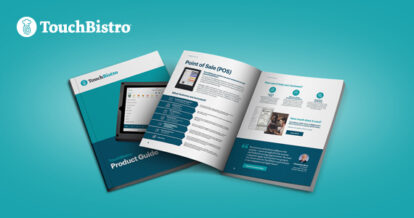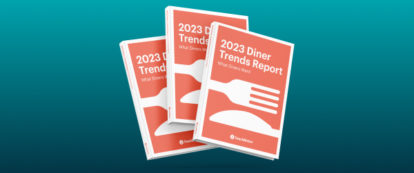You have a restaurant. You have employees. And maybe you have staffing issues.
If you do, you’re not alone – 30% of restaurant owners claim staffing as one of their main pain points. On top of that, 49% of employees will look for another job after just two payroll mistakes.
From recruiting and hiring to onboarding and retention, employee management is a large umbrella. And within that umbrella, there’s payroll – and communicating your restaurant payroll processes and policies to your new employees.
Once you hire someone, completing a new hire checklist for restaurant employees can help each employee understand the fundamentals of compensation and that workplace compliance is crucial to the onboarding process.
To start, employees should know if they’re:
- Being paid hourly or receiving a salary
- Classified as full-time or part-time
- Subject rules and regulations related to tipped wages
Per their actual paycheck, employees should also know:
- How often they’ll be paid — weekly, bi-weekly, semi-monthly, or monthly
- Whether they’ll receive a physical check or direct deposit
- How their income tax withholdings will work
- What payroll taxes are, including employer contributions and employee deductions
Finally, employees need to know the following labor laws that affect their employment:
- Minimum wage
- Overtime
- Breaks
- Paid time off
- Public holidays
Keep reading to find out how to explain these fundamental processes and policies to your new employees, so that your staff starts on the right foot at your restaurant.
How to Explain Compensation to Restaurant Employees
Unless you moonlight as a human resources (HR) expert, you may not know how to accurately explain regulated compensation policies to new hires.
We’ve put together an overview of the big talking points that are normally laid out as part of the hiring and onboarding process for restaurants. Although most people are familiar with these concepts, you’ll want to make sure that employees understand the details of these policies and how they affect the ways they’re paid.
Here are the top three general compensation policies you need to explain to your new employees.
1. Hourly vs. salary
In restaurants, a vast majority of the employees are paid hourly. But certain roles like head chef or management can be salaried. Restaurant owners may also opt to issue themselves a salary.
Here are some of the top-level differences between hourly and salaried workers.
United States
- Hourly (nonexempt workers) are paid at least minimum wage and must also be paid for overtime (as determined by the federal, state, or local standards).
- Hourly employees must track their time.
- Salaried (exempt workers) are paid an annual amount, which is then broken down into regular amounts according to how often the employee is paid.
- “Exempt” means the employee is not subject to minimum wage or overtime rules as long as they are paid a minimum of $455 a week ($23,660 a year).
- Exempt workers must also perform executive, administrative, and professional duties.
Canada
- Hourly (nonexempt workers) are paid minimum wage and subject to overtime according to provincial and territorial standards.
- In Canada, there’s no income exemption for overtime, and non-professional salaried workers are entitled to overtime.
2. Full-time or part-time
The way in which you define full- or part-time work helps set expectations for both the employees and yourself, the employer.
In the United States and Canada, there’s no official standard definition of full- and part-time work – but the general consensus is that part-time is 30 hours per week or less.
Odds are, your hourly staff will be part-time and your salaried staff will be full-time – but this is not guaranteed. Either way, you will need to make sure your new hires understand whether they are considered full- or part-time staff, as this will set expectations for pay, lifestyle, and dedication to their work.

3. Tipped wages
One of the more complex areas of restaurant compensation, tipping is a hotly debated topic, with some restaurants moving away from the practice altogether. If you have tipped employees in your restaurant, your staff need to understand the current rules and regulations for tipping in your region.
United States
- Through a tip credit, you can pay a portion of the minimum wage in direct wages (cash wages), with tipped income accounting for the balance to meet or exceed minimum wage.
- At a federal level, the tip credit is $2.13 as long as the hourly wage with tipped income meets or exceeds $7.25.
- Many states have their own regulations for tip credits, and several states don’t allow for a tip credit. In these cases, state and local laws apply.
- As tips are considered taxable income, employees must report tipped income of $20 or more, once a month to their employer.
- The rules on tip pooling (tip sharing) have recently gotten a little muddier. In March 2018, a federal law was passed allowing tip pooling between tipped and non-tipped employees. Before the law, only tipped employees could participate. Just be aware that many states already have their own laws on tip pooling, so many of the finer points of this rule are still being worked out.
Canada
- Tips are treated as an additional form of taxable income.
- Indirect tips controlled by the employer, like gratuities added as part of an electronic payment, are reported in the employee’s pay stub by the employer. (These amounts are also subject to income and payroll taxes.)
- Direct tips, such as cash left on a table, need to be reported by the employee as part of their personal income tax filings. (Quebec is the only province that requires employees to report direct tips to employers.)
How to Explain Payroll to Restaurant Employees
We’re all human and everyone is happy to see their paycheck. But not everyone understands how restaurant payroll works or what kind of information their pay stub contains. Explaining these concepts to your new employees can go a long way in preventing confusion and showing your employees that you care about their well-being.
1. Pay frequency
Whether you choose to pay employees weekly, semi-weekly, bi-monthly, or monthly, they need to know which days are paydays.
United States
Certain states have laws on how often employees should be paid. You can pay more often, but the minimum standards have to be met.
Canada
In Canada, payroll frequency is governed at a regional level by the provinces and territories. Check to make sure you understand how often you’re required to pay your employees, and make sure they understand why you’re choosing to pay them more often (if you choose to do so).
You can also let employees know their payment schedule in your restaurant training manual.
2. Physical check or direct deposit
While there are no laws mandating either option in the United States or Canada, direct deposit is becoming the norm. But, given the diversity of the restaurant workforce, you may need to provide some employees with paper checks. Either way, your onboarding materials will have to explain why you’re requesting:
- Accurate employee information, including name and address. The name and address on an employee paycheck should also match the name and address on their onboarding tax documents (W-4s in the United States and T4s in Canada).
- Accurate banking information direct deposit. In certain cases, employee consent is also required.

3. Pay stubs
With every paycheck, it’s a best practice to issue a pay stub (pay statement) detailing the amounts paid during that period, including deductions and contributions. You want to ensure that your employees understand the following:
- Income tax withholding: In both the United States and Canada, the employer withholds (takes out) the required amounts of income tax on a federal and state or provincial level.
- Payroll taxes: While most people expect that income tax will be taken out of their paychecks, many employees don’t have a firm understanding of payroll taxes.
Here’s an overview of payroll taxes in the United States and Canada.
United States
- Employment taxes in the United States include Social Security, Medicare, as well as federal and state unemployment taxes.
- Social Security and Medicare (FICA taxes) are split evenly between the employer and employee.
- Federal unemployment taxes are paid in full by the employer.
- State unemployment tax regulations vary on the employee/employer breakdown.
Canada
- Source deductions in Canada include Canadian Pension Plan/Quebec Pension Plan (CPP/QPP) and employment insurance (EI).
- CPP/QPP is split evenly between the employee and employer.
- EI is withheld up to a maximum amount, with the employer contributing 1.4 times the employee amount.
How to Explain Labor Laws to Restaurant Employees
In the United States, the main law that governs minimum wage, overtime, and other workplace practices at a federal level is the Fair Labor Standards Act (FLSA). In Canada, federal guidelines are set by the Canada Labour Code (Part III – Division IV).
Restaurant owners and managers need to know their responsibilities for following these laws, which, in turn, should also be communicated clearly to employees. Here are five labor laws to explain to your new hires at your restaurant.
1. Minimum wage
Minimum wage sets the baseline for paying hourly workers. It’s illegal to pay any less, and violations are costly. You may have also heard that minimum wage has been rising in 2018, so make sure to check whether or not your state or city has been affected this year.
United States
- The federal minimum wage is $7.25, but many states and a growing number of cities have their own minimum wage laws.
- In cases where there are competing laws, the employee is entitled to the highest rate, which is normally the state or city rate.
- If your restaurant is using the tip credit, be sure to outline how this works for your tipped employees.
Canada
In Canada, minimum wage is determined by each province or territory.
2. Overtime
Another form of workforce protection, overtime is an increased rate of pay once an employee has exceeded what’s normal for a standard 40-hour workweek.
United States
- In the United States, the federal standard is time and a half after 40 hours of work in a workweek.
- Many states have their own overtime regulations that set the standards at more than eight hours in a day or 40 hours in a week. Be aware of exemptions for companies with less than four employees.
- Just like with minimum wage, the most employee-friendly laws at the state or city level override other federal laws.
- In California, double overtime (double pay) is owed for 12-hour shifts or for over eight hours on any seventh day of a workweek.
Canada
- In Canada, the federal standard is time and a half after 40 hours in a workweek or eight hours in a workday.
- Many provinces and territories also have their own overtime laws.
- Like California in the United States, British Columbia is the only Canadian province with double overtime, which applies after 12 hours in one day.

3. Breaks
With all the peaks and rush periods in a restaurant workweek, the guidelines for meal and rest breaks should be well-known to everyone in your front and back of house. You probably know how informal behavior can set in when it comes to breaks in the restaurant industry, so make sure you’re explicit about your break policies, for the sake of yourself and for the well being of your employees.
United States
- At a federal level, there’s no law requiring rest or meal breaks.
- If an employer decides to provide short five- to 20-minute rest breaks, this time is counted as being on the clock and, therefore, paid.
- Meal breaks that are 30 minutes or longer are not paid.
- There are currently 20 states that set a minimum length for meal breaks and nine states that have minimums for rest breaks.
Canada
- Rest and meal break requirements are determined at the provincial and territorial levels.
- The most common standard is that an employee is entitled to a 30-minute meal break after five consecutive hours of work.
- Employer and employees can agree to split this time into two 15-minute breaks.
4. Paid time off
Paid time off includes vacation, sick days, and personal days. In the restaurant industry where you have a lot of hourly and shift work, you want to spell out these standards right from the start.
United States
- There are no requirements for vacation, sick days, or personal days at a federal level.
- There are also no mandates at a state level for employers to provide vacation. But do know that many states have laws on vacation pay as taxable income, setting policies on rollovers, and unused amounts.
- Businesses with 50 or more employees must offer up to 12 weeks of medical leave in certain instances under the Family and Medical Leave Act (FMLA).
- The states of Arizona, California, Connecticut, Massachusetts, Oregon, Vermont, and Washington each have sick day laws.
- Personal leave is something an employer can choose to offer and, like other paid time off, it’s subject to any applicable state law.
Canada
- Federally regulated employees are entitled to two weeks of vacation after one year of employment. After six years of consecutive employment, vacation entitlement increases to three weeks.
- The provinces and territories also have their own entitlement guidelines.
- As vacation is accrued based on a percentage of gross wages, both part- and full-time employees accrue vacation.
5. Public holidays
Public holidays are a unique challenge for restaurants, especially for restaurants that are open on holidays. If your restaurant is open or closed for certain holidays, be sure to communicate these dates in person and in your restaurant employee handbook.
You may also set your own rules for how you schedule your staff during holidays. You may feel you want your star staff on the floor during peak holiday shifts, or you may want to reward your top employees with time off during these periods. Either way, make sure your policy is clear in your employee handbook so there aren’t any nasty surprises come holiday scheduling.
United States
- Federal law doesn’t set any standards for vacations and holidays, considering them restaurant employee benefits to be worked out between employers and employees.
- Most states have their own holiday leave laws. But, at this time, only three states require any sort of holiday leave.
Canada
- There are nine statutory holidays for “federally regulated employees”, and provinces and territories have their own list of holidays as well.
- To qualify for “holiday pay” most workers have to have worked a certain number of qualifying hours prior to the holiday itself.
- As the laws vary by province and territory, make sure you apply the correct rules.
Documenting Your Restaurant Payroll Processes
Once you’ve had a chance to familiarize yourself with your own local labor laws, you’ll want to document them in one place for your employees: your employee handbook.
Even if you don’t create a formal handbook, writing things down and outlining policies helps prevent confusion by ensuring that everyone gets the same information.
And don’t forget – proving that you provided your employees with crucial payroll information can also be helpful if you’re ever subject to any legal disputes.
Finally, documenting your payroll policies helps you identify any gaps in understanding – and whether or not you need to get expert advice to fill in the blanks.
Talking about Restaurant Technology with Employees
Like other small businesses, restaurants are benefiting from the rapid growth and development of restaurant technology. In the compensation sphere, you may be using a sophisticated POS with a staff scheduling integration, which allows you to track your labor costs as well as your staff performance.
Great timesavers for management, these apps are also perks for employees who are increasingly reliant on mobile devices. In other words, who calls anyone to switch shifts anymore?
If you are tracking labor within your POS, you may want to mention to your staff:
- How your staff scheduling software affects their ability to switch shifts (it may make their lives easier!)
- How you like to reward employees for high sales during their shifts
- How you like to schedule employees to save on labor costs – so they understand early on why you like a certain number of staff to start just as dinner is really picking up
Along with the convenience these tools provide, you also need to be specific about your policies on switching shifts, tracking time, reporting tips and other matters.
Where to Find More Information
While this article is a general overview, the following is a list of sources that can help you find more detailed information.
Labor Law Sources
U.S. Department of Labor Fair Labor Standards Act (FLSA)
Specific information for restaurants
FLSA for Restaurants PDF
List of State Labor Departments
Employment and Social Development Canada
Labour Program
List of Provincial and Territorial Ministries of Labour
Tax Law Sources
IRS Small Business and Self-Employed Tax Center
Restaurant Tax Center
Employment Taxes (Payroll Taxes)
List of State Tax Departments
CRA Small Businesses and Self-Employed Income Page
Employer Payroll Responsibilities
Alberta Tax and Revenue Administration (TRA)
National Restaurant Associations
National Restaurant Association (NRA)
Workforce Engagement
Restaurants Canada (formerly CRFA)
Industry Issues
Employment Standards
Download your free employee handbook template
Subscribe to the TouchBistro Newsletter







